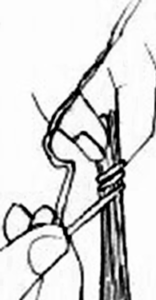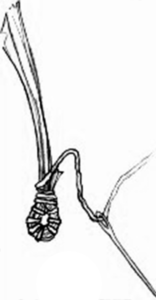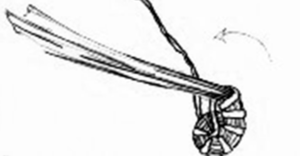How to Coil with Fibres
by Elham Atighi Lorestani

by Elham Atighi Lorestani
Download the designed version for home printing here
Coiling is not weaving. The distinctive feature of this type of basketry is its foundation, which is made up of a single element, or standard, that is wound in a continuous spiral around itself. The coils are kept in place by the thread, the work being done stitch by stitch and coil by coil. Variations within this type are defined by the method of sewing, as well as by the nature of the coil, which largely determines the type of stitch. The most common ones are spiral coiling, sewed coiling and half-hitch and knotted coiling. Historically, this technique was used to create baskets that could hold water, food, or fish.
Common materials used for coiling (cord or yarn) are fibre-flex, sisal, mop yarn, daylily, iris, sweetgrass, pine needles, willow, or straw. For stitching the pieces together or wrapping, a thread-like material such as nettle, palmetto, raffia, or horsehair is usually used. Do not use very soft cord or yarn, these materials compress when stitched, giving an uneven appearance to the baskets.
The fresh strands of natural fibre will shrink and loosen if they are coiled right after harvesting and splitting. lt is important to coil them up and give them a few hours to dry out. Before starting, dampen both the cord and the wrapping fibre for 20 minutes to soften. The fibres should not be soggy, but just dampened enough to make them a little more flexible.

1. Grab a bundle of fibres. The amount of fibres you pick has to be even throughout the whole process so that you get a fine looking result at the end.

2. Be sure to leave an initial¼ inch of the fibre bundle unwrapped at the start. With one hand, hold the short end of the stitching string (wrapping) and with the other, hand wrap the long stitching string around both the string’s end and the fibre bundle. Wrap about 10-15 times, producing a coil about¾ of an inch long

3. Bend the wrapped fibre bundle extremely gently into a ‘U’ shape and bind both the long and the short ends of the bundle together. Wrap 6 to 8 times. This will form a ring foundation. Try to make the hole as small as possible.

4. The next step is threading the loose end of the string through a needle. Stitch around the bundled needles and through the hole at the centre of the ring. Use standard whip stitch.

5.For the second round of stitches, do not stitch through the hole at the centre of the ring anymore, but go around the fibre bundle.

6. Go around the fibre bundle with the string three times, and put the needle from underneath the previous round, and go back to the underside of the bundle again.

7. Repeat the previous step over and over again. Keep going till you reached the desired size.